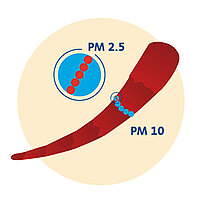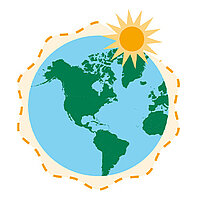
Fires were burning in California, France, Portugal and Greece simultaneously. Even in areas not famed for their susceptibility to forest fires, such as eastern Germany and Siberia, trees burned for weeks.
A major heat wave meant that one year of widespread forest fires turned into another. As early as February 2023, Chile was battling the first inferno of the new year.

The problem is that by releasing CO2, a greenhouse gas, forest fires reinforce climate dynamics. Fires in Siberia are particularly critical in this respect. This is because large amounts of CO2 and methane (a highly active greenhouse gas) are bound up in the permafrost soil there and these too are released into the atmosphere as a result of slow thawing and fires.
But it’s the gigantic clouds of smoke that cause the most immediate problems for people, as residential areas are also increasingly affected by forest fires. Smoke hangs stubbornly between houses, obscuring the sun, and making it difficult to breathe.
People have to flee the flames. The sometimes widespread air pollution can cause serious health problems.
In some parts of the USA, citizens in affected areas are already being advised to change the filters in their HVAC systems regularly.

These individual particles (e.g. dust, pollen, and mold spores, as well as organic and metallic compounds) are many times smaller than a human hair. They can penetrate very deep into the lungs when inhaled.

This poisonous gas is produced when organic substances burn with too little oxygen. Because it does not have an irritative effect when inhaled, it is not noticeable until symptoms such as dizziness or headaches occur. At high concentrations, there is even a risk of asphyxiation, as the blood is prevented from absorbing oxygen.

Ground-level ozone is formed by a chemical reaction between volatile organic compounds (VOCs) and nitrogen oxides. The concentration can increase due to forest fires. Too much ozone in the air irritates the respiratory tract, causes headaches and coughing, and reduces lung function.
This can have both short-term and long-term health effects on people who are exposed to contaminated air over a long period of time. Irritation of the eyes and respiratory tract occurs after just brief contact.
Depending on the intensity and duration, lung function may also decrease and even the cardiovascular system may be affected. Breathing in smoke from forest fires over a long period of time can permanently impair lung function.
Forest fire smoke can spread over vast areas and severely affect air quality even at great distances from the source of the fire. Industrial plants in areas with an increased risk of forest fires must gear their air filtration systems to this risk by using filters that efficiently filter even larger quantities of medium-sized particles fractions without loss of efficiency.
Either way, the risk of forest fires will continue to increase. National and regional governments, as well as the business sector and private households should therefore try to counteract them through effective climate protection and preventive measures on forest land. Filters for the home, public facilities, offices, and production facilities can help to filter fine dusts and other substances from the air to provide the best possible protection for the health of people in affected regions.
Quellen:
https://www.scientificamerican.com/article/when-heat-waves-meet-air-pollution-death-risks-rise-substantially1/
https://www.forbes.com/sites/jamiehailstone/2022/07/13/how-wildfires-impact-our-health-as-well-as-the-environment/?sh=59586ec01442
https://www.greenpeace.de/biodiversitaet/waelder/waelder-erde/2022-jahr-waldbraende
https://www.deutschlandfunkkultur.de/braende-in-sibirien-wenn-der-boden-in-der-tundra-taut-100.html
https://www.spektrum.de/news/waldbraende-wie-der-rauch-der-gesundheit-schadet/1955107